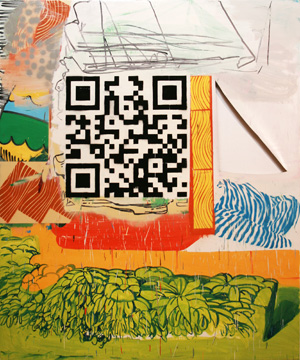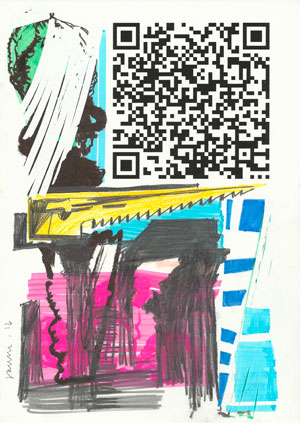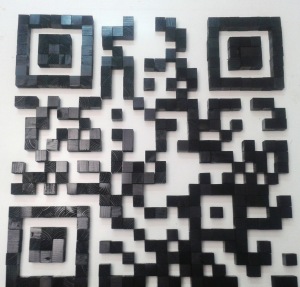
ÉCFRASIS. La écfrasis,(en griego antiguo, εκφραζειν, ‘explicar hasta el final’), es una descripción precisa y detallada, también animada, de un objeto o artefacto de arte. Esta obra de arte puede ser real o ficticia y, a menudo, su descripción está insertada en una narración. Proviene de la locución ekphrasis (‘proclamar, afirmar’ o ‘dar la palabra a un objeto inanimado’), formada del prefijo intensivo ek- y de phrasis, ‘palabra’.
Este blog (ecfrasislaleyenda) se crea en 2010 con el objetivo de ilustrar el proyecto “Écfrasis”. Un proyecto artístico-pictórico que abordaba de forma crítica el problema de la narración (y las relaciones entre literatura y pintura) en la pintura y el arte contemporáneos.
La intención primera era generar un relato en forma de imágenes que suplantara a la narración textual con la que suele introducirse y justificarse este tipo de proyectos (y el quehacer artístico contemporáneo en general). De forma paralela a la ejecución de los cuadros del proyecto, se fueron almacenando y catalogando cada uno de los elementos (que de forma parcial o fragmentaria) aparecían representados en los mismos. Fotografías, recortes de prensa, textos, etc.
Con el tiempo y el desarrollo del proyecto, estos elementos fueron “ordenados” en forma de leyenda, al estilo “mapa de carreteras”, generándose una especie de “guía” encriptada para la lectura de los cuadros. Así es como se presentan en el catálogo que recogió la primera exposición del proyecto (LA LEYENDA. JAVIER MARTÍN. Que puede consultarse on line en la sección “catálogos” de este blog).
encriptada para la lectura de los cuadros. Así es como se presentan en el catálogo que recogió la primera exposición del proyecto (LA LEYENDA. JAVIER MARTÍN. Que puede consultarse on line en la sección “catálogos” de este blog).
Cada elemento fue anotado como un epígrafe, marcado con un pequeño símbolo que remite a una breve narración textual en forma de nota-leyenda al final del catálogo. Esto añadió un nuevo sentido al proyecto: el ambivalente significado de la palabra leyenda (como método de lectura o anotación y como historia semi-ficticia) aludiendo, no solo el exceso en el uso de lo narrativo en el arte actual, sino a lo narrativo como fuente de, una siempre sospechosa, fidelidad y fiabilidad.
De este modo, las micro-narraciones de “La Leyenda” iban desde la cita filosófica, la literaria, pasajes biográficos, el humor o las historias inverosímiles y alguna directamente falsa.
El otro aspecto, nuevo, era la posibilidad de cartografiar la pintura, algo que además ampliaba y multiplicaba de forma burlona el permanente juego semántico (como en un jeroglífico y al estilo de comentario “duchampiano”) entre los elementos de “La Leyenda”.
Aunque en la serie “Écfrasis (La Leyenda)” ya habían aparecido representados fragmentos de Códigos BIDI-QR code, en inglés- (como una alusión a la encriptación del contenido de los cuadros), es a partir de 2012 que empiezo a incluirlos de forma completa y funcional (Es decir, representados de tal forma que funcionan al pasarles el escáner del teléfono móvil).
 Este hecho enriquece la inmediatez de esta “cartografía” de la Pintura; dado que no es necesario más que un teléfono móvil para acceder a los contenidos ocultos de cada pintura y me proporciona la posibilidad de enlazar los cuadros no solo a imágenes y textos: canciones, videos, web, blog, etc. están al alcance.
Este hecho enriquece la inmediatez de esta “cartografía” de la Pintura; dado que no es necesario más que un teléfono móvil para acceder a los contenidos ocultos de cada pintura y me proporciona la posibilidad de enlazar los cuadros no solo a imágenes y textos: canciones, videos, web, blog, etc. están al alcance.
El blog y en particular la sección “La Leyenda”, han dejado, desde entonces, la función de archivo de aquellos elementos (imágenes, recortes, etc.) que recibió en un primer momento; recibiendo un uso más común; el de diario de pintor.
—————————————————————————————————–
EKPHRASIS. Ekphrasis (in old Greek , εκφραζειν, “explain to the end”) is a precise, detailed, also an animate description of an object or artifact of art. This work of art can be real or fictitious, and its description is often inserted in a story. The word comes from the Greek intensive prefix ek- and phrasis, “out” and “speak” respectively, verb ekphrazein (“to proclaim or call an inanimate object by name”).
Ekphrasis is a project in progress since October 2010. It deals with the different ideas of “narration” that emerge around the artistic work. More specific, it consists in the creation of a legend about my pictorial work. — Legend: (From latin leyenda, pl. n. of the gerund of legere, read). 5.f. Text which accompanies a map, an illustration, a painting, etc.—
The Legend nourishes on different objects, texts and photos from daily life. Sometimes they are objet trouvè, and other times, book pages I´m interested in. Being the blog sited in the net, a web link, a link to a song, etc. may be part of The legend too.
The point is to extend the elemental legend of a work of art: the title. That is, to extend the title by using micro-stories in the shape of objects and images.
These elements become the starting point of the paintings and, besides, they serve me to narrate the work, in this case, the painting. I mean that I use them as the story itself. I consider that they are the most accurate description of the work. In fact, that they are the legend of the work; the references that go with the painting and must function as keys to interpret or read the painting. They serve as a platonic three-dimensional photo of the work since its own genesis.
They are objectual phrases (There are some examples in this blog). I call them objectual phrases because by presenting them sequentially, they acquire the role that words have in a sequence is the same as the among the subject, the predicate and the complements in a textual phrase.
This way I try to replace the artist´s tale story (intentions, interests, references) by a narration in images, objects, etc. that are close and directly connected with the painting.
So the paintings are seen as a map, as a hieroglyphic / puzzle which way access is through a legend.